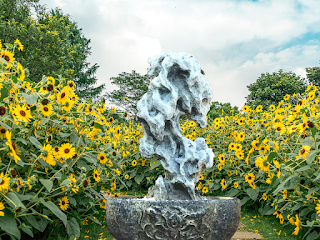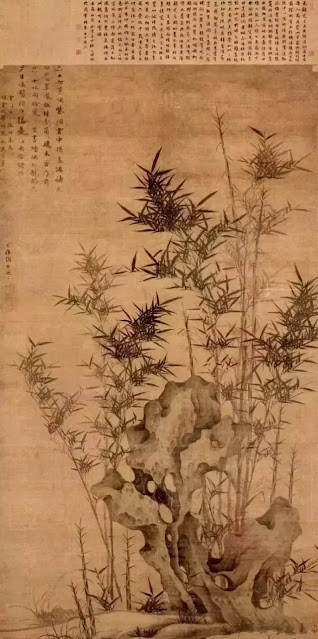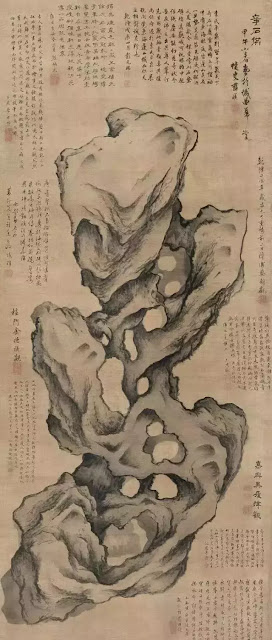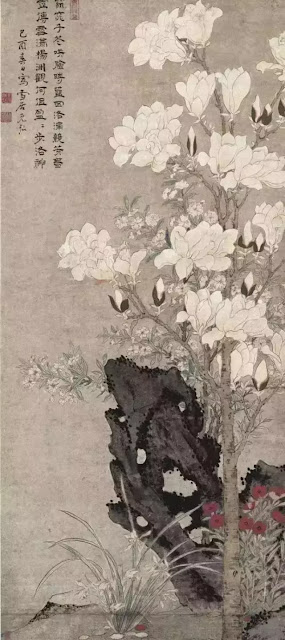Heaven and earth live side by side with me, and everything is one with me. To appreciate nature is to discover oneself.
In the historical Chinese paintings, there are various mysterious and strange stones, which make people full of endless reveries.
Historically, mountains and rocks have been exploited and developed by people and used as decoration in the courtyard, making the originally monotonous courtyard lively.
The number of natural stones such as the sands of the Ganges River cannot be measured, but throughout the ages, only the Chinese loved and understood stones best. Ancient private royal gardens, princes and nobles, and scholars all regarded having a good stone as elegant.
The stones that interlocked with each other seemed to them an infinite world that was constantly changing. In the past, the elites and sages cherished their thoughts and thoughts in the boxing stone.
The body in "Zhuangzi•The World" is incomplete and detached from the world, and the viewer can taste the beauty of innocence and innocence, appreciate the life philosophy of being clumsy and reckless, and free the mind that pays attention to aesthetics from the fetters of the world.
With such a concept to care for the stone, it is not difficult for us to understand the sentence of the Qing Dynasty literary theorist Liu Xizai who pointed out in the "Art Overview" that "the ugliness of a strange stone is beautiful, and the extreme ugliness is the extreme beauty".
Niu Sengru, who lived as the respected aspect in the Tang Dynasty, was a person who loved collecting Taihu stones.
Bai Juyi called him "when he rests, he stays with the stone", and even "to treat him like a friend and a friend, a close friend like a sage, and a precious stone. To the extent that love is like a child and grandchild, one can see the depth of his love for the stone.
Modern people who are accustomed to the fast pace of the city are more eager for a lively and calm life. Fusheng steals for half a day, hides in the small room, sips tea, and paired it with the simple and elegant classical stone appreciation. It is so pleasant to feel the beauty of the stone.
There is no stone in the room, and no stone in the house. The Chinese stone appreciation culture has a long history. Since the Tang and Song Dynasties, Shi Ping has been published. In the Tang Dynasty, there was "Tahu Shi Ji" by Bai Juyi, and the Song Dynasty also has a rich and detailed description in the "Yunlin Shi Pu".
The culture of appreciating stone in Ming and Qing dynasties developed to its heyday. Many works such as Yuanye, Qunfang Pu, and Xianqing Ou Ji discussed in detail about appreciating stone.
There are also many famous artists who have collected, appreciated and painted stones in the past. Let’s look at the classic painted stones of the past masters today!
In the chinese painting above, the man in red, pointing at the tall and weird stone in front of him, looked very surprised!
This huge rock is slightly tilted, and looking at him as if he will fall down at any time, it is shocking!The servants around him are also talking about this strange giant rock.
Friends, what do you think of this strange stone? Give full play to your imagination! Leave your thoughts in the comment area!
Xu Xi (886-975 AD),The work I painted in between is mainly the green bamboo scene in the snow. The name of the chinese painting does not mention the word stone, but it is obviously very beautiful and strange against the snow-covered stone and green bamboo.
The stone in the chinese painting occupies a small proportion in the painting, but it is precisely because the snow is covered with snow that the white stone looks dazzling in the painting, oh as if a little snowman is piled up at the feet of relatives, giving the whole painting the finishing touch. Effect.
Due to the emperor’s advocacy, high-ranking officials, nobles, gentlemen, merchants, and gentry rushed to follow suit. So the ruling and the people went up and down to search for strange stones for appreciation, which once became the fashion of the Song Dynasty.
During this period, not only masters of stone appreciation such as Mi Fu and Su Shi, but also literary and political celebrities such as Sima Guang, Ouyang Xiu, and Wang Anshi all became influential active participants in the collection, evaluation and appreciation of strange stones at that time.
The emperor's Chinese paintings are very delicate, and the details of the stones are fully displayed, which shows that the emperor's calligraphy and painting are very careful and meticulous.
To be honest, after seeing the strange stone painted by the emperor, my first impression of this Chinese painting was a big bird.
Oh, I don’t mind if you guys laugh at me like this, but you can also give full play to it. With your imagination, what do you think this Chinese painting looks more like in your eyes? Then you can leave your thoughts in the comment area.
Hey, don’t say this looks a bit like the Wuzhishan in China’s Journey to the West .
The great calligrapher and painter of the Song Dynasty, Mi Fu, is the most famous stone idiot in ancient and modern times. He behaved madly, known as "Mi Dian".
He was fascinated by playing with stones. The most famous is the story of "Mi Fu worshiping stone".
Song Dynasty Ye Mengde’s "Swallows of the Stone Forest" records that Mi Fu first entered the prefecture, and when he saw a strange stone, he "called a brother" and worshipped nine times when he saw a strange stone.
Moreover, in Xiangshi, he also created a set of theoretical principles, that is, the four-character tactics of "thin, transparent, leaking, and wrinkle" that have been used for a long time in later generations.
The Northern Song Dynasty court flower and bird painter Zhao Chang's "Sui Dynasty Picture" depicts plum blossoms, daffodils, camellia, periwinkle and lake stones.
Different from other famous works of the same subject, it does not leave blank, and every corner of the picture is crowded, with natural vitality like fire. The rich colors and the compelling composition create a beautiful and joyful atmosphere.
The strange stone in this Chinese painting looks more like a black sheep. In this work, the plum blossom, camellia, narcissus and periwinkle are painted with cinnabar, white powder, rouge, and stone green, and then filled with azurite, the colors are bright and magnificent.
Its composition is special, with lake rocks and densely interlaced flowers covering the whole picture, leaving no space, neat and serious, with a very decorative effect.
Zhao Mengfu was one of the famous stone admirers at that time. Many calligraphy and paintings in Yuan Dynasty, including the four schools of the Yuan Dynasty, had classic stone admiring themes.
Zhao Mengfu is a master of calligraphy, but Zhao Mengfu's achievements are not only above calligraphy, his paintings, or calligraphy and painting, are also unique.
In ancient times, people's appreciation of painting was not limited to painting itself, but a combination of calligraphy and painting. Therefore, many painters were also masters of calligraphy, and Zhao Mengfu's calligraphy and painting were also unique.
Zhao Mengfu's paintings have the meaning of connecting the past and the future. He inherits the advantages of the predecessors, absorbs the essence of the art of the predecessors, and at the same time has a great inspiration for the paintings of the later generations.
For the study of the history of Chinese painting, Zhao Mengfu is the one who will never get around. The Yuan Dynasty was an important transitional period in China.
This was not only in terms of political, economic and social development, but also a transitional period of culture, especially calligraphy and painting. Zhao Mengfu was a great figure in the transitional period of painting in the early Yuan Dynasty.
It was he who promoted the changes in painting and provided the direction for the changes in later generations.
If pen and ink are just techniques, Skills can always be mastered. But Ni Zan’s composition is the simplest, and his brushwork is the simplest. Why hasn't anyone learned alike for six to seven hundred years?
It is said that Ni Zan’s courtyard is very clean. Every day, the servants in his family kept cleaning and taking care of it, so the rockery in the yard was basically spotless. Even the sycamore trees planted in the yard, from bark to leaves, had to be wiped every day, looking as clean as new.
Good plane tree, I was tortured by bathing all day, Therefore, his family's phoenix tree has not been able to support it all the time!
Even the strange rocks in his courtyard are required to be cleaned by the servants every day.
Wang Meng. He was particularly good at painting landscapes, and won his grandfather Zhao Meng's dignity, and he became his own face with Dong Yuan and Juran as his ancestors. The work wins with the complexity, the layout of multiple mountains and rivers, and the interaction of dry and wet, sending the beauty and freshness in the thick and muddy.
The moss is more burnt and the ink is thirsty, and it moves down, expressing the lush and vast atmosphere of the forest. There are two commonly used methods, such as Jie Suo Zhu and Niu Mao Zhu.
One is easy to use the curling pen like an earthworm, which is known for its use of pen to change and "complex"; the other is to use "light ink hook stone bone, pure Rub it with burnt ink, so that there is no room in the stone, and then break it, and hope it will be very beautiful."
In addition to the landscape, he is also capable of being a character. His works had a great influence on Ming and Qing landscape paintings, second only to Huang Gongwang. Later generations called him the "Four Masters of the Yuan Dynasty" together with Huang Gongwang, Wu Zhen and Ni Zan.
Dong Qichang once wrote an inscription in his work: "The prince can carry the power of the pen, and there has been no such monarch in five hundred years." In the "Painting History and Painting Essentials", it said: "Wang Meng's landscape master has to use ink." And Yun Nantian even said that he was "Yuanzong Mojie (Wang Wei)".
From the perspective of "Wild Bamboo Drawing", Wu Zhen not only inherited the bamboo painting theory of Wen Tong and Li D, but also made creative breakthroughs.
Wu Zhen pays more attention to the non-realistic nature of bamboo painting, and highlights the mental state of bamboo.
"Wild Bamboo" paints clear bamboo or wind bamboo with "leaves up and down". Similar works can be seen in Wu Zhen's collaboration with Wang Mian in "Plum and Bamboo Shuangqing" and "Duo Futu".
In addition, Wu Zhen also pays attention to the resonance between the effect of the picture and the viewer, plus the deep meaning conveyed by the poem inscribed on the painting, presenting the supreme enjoyment of the literati paintings.
This Chinese painting is very classic. The painter uses light colors to paint bamboo and dark and light colors to paint strange rocks. The plants and stones are separated very clearly and clearly, which enhances the three-dimensional layering. It is a painting worthy of appreciation.
The strange stone in this Chinese painting, the holes in it, and the stone itself form a concept of space, making it seem that the vicissitudes of history can be seen on this strange stone. Generally speaking, this Chinese painting is my favorite type, is it also your favorite type?
Zhu Derun was born in a famous family in the Soochow, a scholarly family. He is eight feet long and beautiful, and he can never forget his reading. Young is beautiful and unique, and the landscape figures have the style of ancient authors.
His traditional Chinese paintings include plains, mountains and rivers, forests and forests, the brushstrokes are beautiful and powerful, and the scenery is full of realism.
The stone landscape of this Chinese painting accounts for one-third of the entire Chinese painting. It can be seen that the stone landscape is very important in the design of ancient Chinese gardens, especially the strangely shaped stones are more attractive!
What do you think this strange stone looks like? Welcome to write down your thoughts in the message area!
The calligrapher and painter Mi Wanzhong of the Ming Dynasty not only loves stone as an addiction, but also has a wealth of stone, and he also left some paintings of stone.
The painting stone in this work is similar to Taihu stone, with realistic meticulous brushwork, with a metamorphic color, similar to Wu Bin's style of painting stone, the stone is sharp and hard, the stroke is flexible, the stipple is light and flexible, and the ink color is varied.
If this Chinese painting did not tell you that it was a stone, you would never have imagined that it was a strange stone at a glance. Maybe you will imagine that he is a weird cloud, like a coral reef in the sea.
Most of his landscape paintings show the majestic and steep mountains and mountains, pavilions, creeks and bridges, and the scenic landscapes of the four seasons.
Some depict the pavilions and gardens, and the leisurely life of literati and escorts. The landscape figure paintings are large-scale and majestic, small-scale clear and unrestrained, and the subject matter is rich and diverse.
When I saw this Chinese painting, my God, the stone in this painting was so weird.
We saw this traditional Chinese painting. It is a more traditional ranking composition method. The most central part of this painting is placed with a weird stone. It is not monotonous, and orchids are painted as the front attractions.
This strange stone looked like a boxer, posing a posture to attack, making people afraid to approach.
Oh! What I like most about this Chinese painting is the crown-like headdress on its head. What do you like about it?
Oh! My goodness! The strange stone in this Chinese painting is very special. The whole painting is a huge weird stone with Chinese calligraphy. It is very beautiful in simplicity.
Guess what I think of? Isn’t this the huge, mighty and terrifying Tyrannosaurus in Jurassic Park?
Is he now a dinosaur fossil? Hehe! It's a joke, of course not. In this ancient Chinese painting, the wisdom of the ancient Chinese for aesthetics is shown.
In this traditional Chinese painting, the slope stone is sparsely drawn with light ink and dry brush, and the shape is rendered with ink brush and moss is added, which is quite alive.
The whole scene is set off from the front and back, and the scene is scattered.
"Yutang Lanshi Tu" was made in the 37th year of Wanli (1690), when Sun Kehong was 78 years old. Next to the pictured boxing stone, magnolias and orchids compete to open up.
The painting methods of flowers and stones are extremely meticulous, and the magnolia flower is lightly dyed with powder many times to separate the shades, and then outlined with a fine brush to highlight the plump whiteness of the petals.
The branches and trunks are filled with color and rubbed with double hooks, which is very rich in texture. The painting method of the mountain stone is to outline the outline with light ink, and then blend it with heavy and light ink several times, gradually deepening it, until it shows the rich front and back layers and the texture of the stone body. The rocks are exquisite and hard, while the magnolia and orchid are graceful and soft.
This traditional Chinese painting has bright and beautiful colors, delicate layers, subtle changes, and elegant elegance. It is a masterpiece of Ming Dynasty meticulous flowers and birds.
In ancient times, the culture of appreciating stone originated earlier and can be traced back to the Qin and Han dynasties. Through the singing of poets in the Tang Dynasty, Song people's love for stones has greatly deepened.
The number one at the time was Song Huizong. The "Hua Shi Gang" criticized by posterity was the emperor of the painter-one of the most well-known misdeeds.
Class means transportation team, ten ships are a class. At the end of the Northern Song Dynasty, Cai Jing was ordered by Huizong of Song Dynasty to collect strange stones everywhere, and the people were miserable wherever the flower and stone fleet passed by.
In some places, it is common to demolish bridges and scuttle the city gates in order to allow the fleet of large stones to pass.
And the composition of this traditional Chinese painting looks very close. It seems that the pile of strange rocks on it may collapse at any time. It is precisely because of this kind of tension when appreciating this Chinese painting that it is the significance of this strange stone of the Chinese painting.
Wu Weishan painted freehand ink and wash, characters, landscapes, based on the physique of the Southern Song Academy of Painting, and his brush and ink are arbitrary and full of charm. He was an innovative painter in the middle of the Ming Dynasty.
In the early years, the painting method was more meticulous, but after middle age, he became vigorous and bold, with a splash of ink. Wu Wei is a famous general of the "Zhe School" after Dai Jin. He has many followers and formed the "Jiang Xia School" that flourished in the Ming Zhe School.
The life breath of the works is very strong, and the performance skills are relatively fresh and free. In his early years, his painting style was relatively meticulous, but after his middle age, he became vigorous and bold, with a splash of ink.
The magical thing about this Chinese painting is that when you look across your mobile phone, the strange stone in the Chinese painting immediately becomes a teddy dog running happily.
As for this Chinese painting, we can see that it adopts the state of strips to arrange the composition, and uses the S-shaped three-dimensional layered space, using the technique of near dark and far light. Make this Chinese painting no matter the artistic conception Both the composition and the composition have reached a perfect state. This traditional Chinese painting is born from near to far. It also expresses the author's beautiful yearning for the future life, implying that the new life should look forward rather than backward.
Gao Fenghan was born in the scholarly family. His father was Juren during the Kangxi period, who was a master of poetry and plum painting. His uncle Gao Yuecong was a scholar, and his cousin Gao Fengju was also a master of poetry and painting. His own talent and family edification made Gao Fenghangong good at writing poems, fond of seal cutting, good collection, and fine appreciation.
Gao Fenghan paints landscapes, free and easy. He is good at flowers and birds. "The style of Gao Fenghan's landscape painting is very different before and after the right-handed to left-handed painting. In his early years, the landscape did not deviate from the traditional and authentic painting style.
This strange stone in the Chinese painting, you can see that wild mushrooms grow under the feet of the stone. Generally, the places where wild mushrooms can grow in the natural environment are generally relatively humid.
Oh, this verifies my judgment. In fact, it is exactly In this way, we can clearly see in this Chinese painting that many tiny plants have grown on the surface of the stone, covering most of the entire stone, which is like tailor-made for this stone. A lucky dress. It shows that the writer was very careful when painting this painting, so he could paint such an amazingly beautiful and strange stone.
Hu Gongshou (1823—1886), a native of Huating (now Songjiang, Shanghai). The first name is far away, the name is Shouhe, Xiaoqiao, and the other name is Hengyun Shanmin, and he lives in Shanghai. Painting landscapes, orchids and bamboos, flowers, and drawing the best of ancient and modern families, they become a great master.
Famous celebrities in Jiangsu and Zhejiang are all convinced. Calligraphy goes between the plains and the North Sea, and is unique in its specific situation. Shizong Shaoling, Qingjian Zunlian. He is one of the representative painters of the Shanghai School of Painting.
This Chinese painting was supposed to be when the author went to a forest that no one had visited before, and suddenly found a very strange stone in front of him, so he quickly took out his painting tools and carefully took the picture in front of him. The strange stone painting has become a famous masterpiece.
join us now !
Contact us: linlanedu@gmail.com














































No comments: